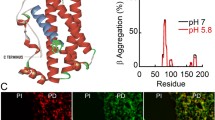Summary
The accumulation of amyloid in pituitary adenomas was examined in relation to the types of adenoma and the effect of bromocriptine treatment. Amyloid had accumulated in 34 of 48 adenomas (71%). The occurrence in prolactin-secreting adenomas and growth hormone-secreting adenomas was 79%, respectively, while that in non-functioning adenomas was 50%. Treatment with bromocriptine enhanced the occurrence and extent of the amyloid accumulation in prolactin- or growth hormone-secreting adenomas. Electron microscopy revealed the initial appearance of the amyloid fibrils in the smooth endoplasmic reticulum and a possible sequential process of their release from the cells. The presence of secretory granules in vesicles containing amyloid fibrils and their simultaneous release with amyloid fibrils suggested that degradation of secretory granules was involved in the formation of amyloid.
Similar content being viewed by others
References
Barr R, Lampert P (1972) Intrasellar amyloid tumor. Acta Neuropathol (Berl) 21:83–86
Bilbao JM, Horvath E, Hudson AR, Kovacs K (1975) Pituitary adenoma producing amyloid-like substance. Arch Pathol 99:411–415
Dannies PS, Rudnick MS (1980) 2-Bromo-α-ergocyptine causes degradation of prolactin in primary cultures of rat pituitary cells after chronic treatment. J Biol Chem 255:2776–2781
Glenner GG, Harbaugh J, Ohms JI, Harada M, Cuatrecasas P (1970) An amyloid protein: The amino-terminal variable fragment of an immunoglobulin light chain. Biochem Biophys Res Commun 41:1287–1289
Guyda HJ, Whyte S (1975) Heterogeneity of human growth hormone and prolactin secreted in vitro: Immunoassay and radioreceptor assay correlations. J Clin Endocrinol Metab 41:953–967
Hazard JB, Hawk WA, Crile G Jr (1959) Medullary (solid) carcinoma of the thyroid. A clinicopathologic entity. J Clin Endocrinol 19:152–161
Johnson KH, Stevens JB (1973) Light-and electron-microscopic studies of islet amyloid in diabetic cats. Diabetes 22:81–90
Krieger DT, Liotta AS, Brownstein MJ, Zimmerman EA (1980) ACTH, β-lipotropin, and related peptides in brain, pituitary, and blood. Recent Prog Horm Res 36:277–344
Kuratsu J, Matsukado Y, Miura M (1983) Prolactinoma of pituitary with associated amyloid-like substances. J Neurosurg 59:1067–1070
Landolt AM (1975) Ultrastructure of human sella tumors. Acta Neurochir [Suppl] 22:1–167
Meyer J (1968) Fine structure of two amyloid-forming medullary carcinomas of thyroid. Cancer 21:406–425
Mori H, Mori S, Saitoh Y, Moriwaki K, Iida S, Matsumoto K (1985) Growth hormone-producing pituitary adenoma with crystal-like amyloid immunohistochemically positive for growth hormone. Cancer 55:96–102
Mori H, Mori S, Saitoh Y, Arita N, Aono T, Uozumi T, Mogami H, Matsumoto K (1985) Effects of bromocriptine on prolactin-secreting pituitary adenomas: Mechanisms of reduction in tumor size evaluated by light- and electron-microscopic, immunohistochemical and morphometric analyses. Cancer 56:230
Osamura RY, Watanabe K, Komatsu N, Ohya M, Kageyama N (1982) Amorphous and stellate amyloid in functioning human pituitary adenomas. Histochemical, immunohistochemical and electron microscopic studies. Acta Pathol Jpn 32:605–611
Pearse AGE, Ewen SWB, Polak JM (1972) The genesis of apudamyloid in endocrine polypeptide tumours: Histochemical distinciton from immunamyloid. Virchows Arch [Cell Pathol] 10:93–107
Porta EA, Yerry R, Scott RF (1962) Amyloidosis of functioning islet cell adenomas of the pancreas. Am J Pathol 41:623–631
Schober R, Nelson D (1975) Fine structure and origin of amyloid deposits in pituitary adenoma. Arch Pathol 99:403–410
Sinha YN (1980) Molecular size variants of prolactin and growth hormone in mouse serum: Strain differences and alterations of concentrations by physiological and pharmacological stimuli. Endocrinology 107:1959–1969
Sletten K, Westermark P, Natvig JB (1976) Characterization of amyloid fibril proteins from medullary carcinoma of the thyroid. J Exp Med 143:993–998
Tischler AS, Compagno J (1979) Crystal-like deposits of amyloid in pancreatic islet cell tumors. Arch Pathol Lab Med 103:247–251
Westermark P (1973) Fine structure of islets of Langerhans in insular amyloidosis. Virchows Arch [Pathol Anat] 359:1–18
Westermark P, Grimelius L, Polak JM, Larsson L-I, Van Noorden S, Wilander E, Pearse AGE (1977) Amyloid in polypeptide hormone-producing tumours. Lab Invest 37:212–215
Author information
Authors and Affiliations
Rights and permissions
About this article
Cite this article
Saitoh, Y., Mori, H., Matsumoto, K. et al. Accumulation of amyloid in pituitary adenomas. Acta Neuropathol 68, 87–92 (1985). https://doi.org/10.1007/BF00688628
Received:
Accepted:
Issue Date:
DOI: https://doi.org/10.1007/BF00688628




